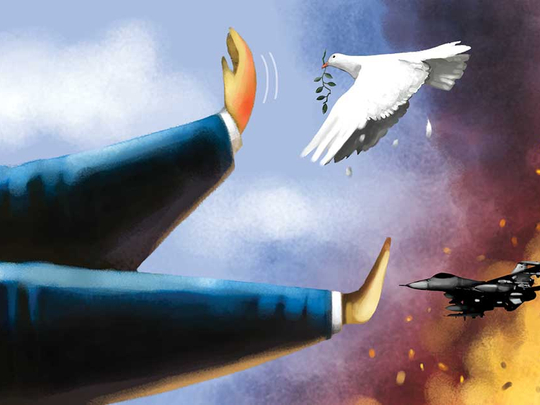
How many times have we been around this block before — and not just in Syria? A ceasefire is proposed by outside powers; it is sort-of accepted by the most representative group of combatants you are going to get, only for it not to materialise either on the appointed day, or at all. For all the weary pessimism that has greeted it, however, the ceasefire — or, to be precise, halt to “combat operations ” — discussed by the US President Barack Obama and Russian President Vladimir Putin on Sunday, made public on Monday and accepted by most parties on Tuesday, deserves a more positive international response than it has so far received.
One reason why disbelief should be at least suspended is that this is not actually the umpteenth time we have been around this particular block in Syria. It is rather the de facto extension of the ceasefire arrangement agreed under UN auspices by John Kerry, the US secretary of state, and his Russian counterpart, Sergei Lavrov, less than two weeks ago. It was accepted then that the timetable — for firing to stop within the week — was ambitious, and so it proved.
Now, with the extra imprimatur provided by Obama and Putin, it appears to be back on. It took the Syrian government and the main opposition umbrella group only hours to accept. If a ceasefire, however imperfect, starts to come into effect this weekend, that will not be too bad as these things go. It is, after all, the first serious attempt at halting the fighting between the troops still loyal to Bashar Al Assad’s government in Syria and the disparate forces arrayed against him. It deserves, in the old cliché, to be given a chance.
The scope of the agreement is more limited than anything mooted at the Vienna talks last year, which are still in abeyance. The main purpose — so far the only purpose — is to halt the fighting in particular areas for long enough to facilitate the delivery of humanitarian aid and perhaps also the rescue of the wounded and sick civilians.
For as long as it holds (if it does), the ceasefire will show whether there is enough of a command structure to make further agreements feasible — possibly agreements with a more political dimension. Even if compliance were only patchy, that would still be an improvement on the war zones that pockmark Syria today. It might also indicate any potential for one or more no-fly zones or secure areas where displaced civilians could be safe.
There has been a widespread assumption that Russia’s military intervention last autumn scuppered any plan for a no-fly zone, as Russian planes were most active over the very airspace where a secure zone had been envisaged. Russian officials, however, have never ruled out the concept, and a location guaranteed jointly by Russia and the US would carry more conviction in current circumstances than one ordained by the US and its immediate allies alone.
Disparate and conflicting interests
It is frequently argued that the number of combatants and their patrons now embroiled in the Syria conflict, as well as the many disparate and directly conflicting interests they represent, militates against any settlement, perhaps for many years. What began as a challenge to Al Assad’s rule and grew into a civil war, so the thinking goes, is nowhere near exhausted. None of the parties are anything like running out of money, manpower or political will.
Russia’s involvement is presented by US and other western officials as especially destructive. Moscow’s air support for Al Assad’s forces, it is argued, has extended his regime’s life and only ensured that the war will go on. Last week the US and UK accused Russia of targeting schools and hospitals in areas that are against Al Assad’s rule. A new and insidious argument has now entered the mix, with western charges that Russia sees the refugee crisis as a way of weakening, and perhaps destroying, the European Union.
Suffice to say that this is not how developments in Syria are presented by Russia, where air strikes on Aleppo, for instance, are seen as facilitating liberation, not frustrating a just revolution. But there is also a glaring disconnect between the loud condemnation of Russia in, say, Washington and London, and the talks that are being discreetly conducted at the highest level — and that result, every now and again, in public agreements. You will also hear highly placed US officials increasingly admitting that the administration’s insistence on removing Al Assad was a huge mistake.
From all these elements it might be possible to draw three conclusions. First, the US and the UK need rhetorical cover to mask a major policy U-turn, which is still in progress.
Second, Russia may have less appetite for a prolonged intervention than is often assumed; it has already suffered losses and may suffer more. Third, neither Moscow nor Washington wants the third world war that the looming confrontation between Russia and Turkey could trigger.
Whether these could add up to an actual Syria peace deal must be doubted. For all the talk about a new Cold War, the bipolar world is over — even the US and Russia together probably cannot impose their will. The latest agreement, though, could be enough to allow a first coordinated relief effort. It should not be written off before it has even had a chance to begin.
— Guardian News & Media Ltd
Mary Dejevsky is a writer and broadcaster and a member of the Valdai Group and a member of the Chatham House think-tank.







